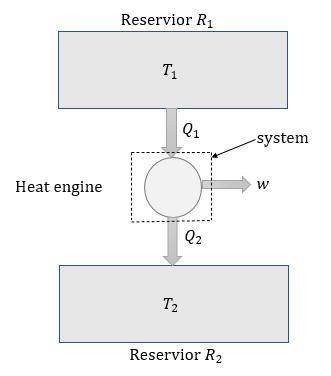
A reversible heat engine, operating in a cycle, withdraws thermal energy from a high-temperature reservoir (the temperature of which consequently decreases), performs work w, and rejects thermal energy into a low-temperature reservoir (the temperature of which consequently increases). The two reservoirs are, initially, at the temperatures T1 and T2 and have constant heat capacities C1 and C2, respectively. Calculate the final temperature of the system and the maximum amount of work which can be obtained from the engine.

Answers: 2


Another question on Physics

Physics, 22.06.2019 09:00
Abicycle slows down when the rider applies the brakes. what type of energy transformation is involved in this example? a. kinetic energy into heat energy b. heat energy into potential energy c. potential energy into kinetic energy d. kinetic energy into mechanical energy
Answers: 1

Physics, 22.06.2019 18:30
Two 2.0-cm-diameter disks face each other, 1.0 mm apart. they are charged to ±10 nc. what is the electric field strength between the disks? a proton is shot from the negative disk toward the positive disk. what launch speed must the proton have to just barely reach the positive disk?
Answers: 1

Physics, 22.06.2019 19:30
Amass m = 74 kg slides on a frictionless track that has a drop, followed by a loop-the-loop with radius r = 18.4 m and finally a flat straight section at the same height as the center of the loop (18.4 m off the ground). since the mass would not make it around the loop if released from the height of the top of the loop (do you know why? ) it must be released above the top of the loop-the-loop height. (assume the mass never leaves the smooth track at any point on its path.) 1. what is the minimum speed the block must have at the top of the loop to make it around the loop-the-loop without leaving the track? 2. what height above the ground must the mass begin to make it around the loop-the-loop? 3. if the mass has just enough speed to make it around the loop without leaving the track, what will its speed be at the bottom of the loop? 4. if the mass has just enough speed to make it around the loop without leaving the track, what is its speed at the final flat level (18.4 m off the ground)? 5. now a spring with spring constant k = 15600 n/m is used on the final flat surface to stop the mass. how far does the spring compress?
Answers: 3

Physics, 23.06.2019 08:30
Look at the electroscope, describe how you can cause the two leaves at the bottom to repel each other and stay that way
Answers: 3
You know the right answer?
A reversible heat engine, operating in a cycle, withdraws thermal energy from a high-temperature res...
Questions

Social Studies, 27.11.2021 04:40

Social Studies, 27.11.2021 04:40


Chemistry, 27.11.2021 04:40

English, 27.11.2021 04:40




Biology, 27.11.2021 04:40



Computers and Technology, 27.11.2021 04:40


Health, 27.11.2021 04:40

Mathematics, 27.11.2021 04:40



SAT, 27.11.2021 04:40



 .
. is the reservior having temperature
is the reservior having temperature  and heat capicity
and heat capicity  and
and  is the reservior having temperature
is the reservior having temperature  and heat capicity
and heat capicity  .
. .
. heat is extracted by the heat engine from the reservior
heat is extracted by the heat engine from the reservior  to
to  heat is rejected by the heat engine to the reservior
heat is rejected by the heat engine to the reservior 
 .
. .
.



 [taking anti-log both the sides]
[taking anti-log both the sides]





 ,
,



